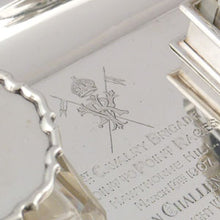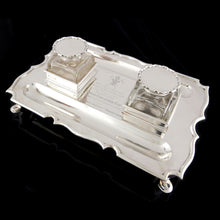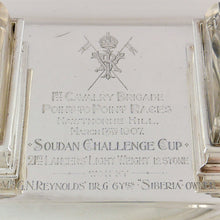21st Lancers - 1st Cavalry Brigade Prize Inkstand, 1906
- Regular price
- £1,575
- Sale price
- £1,575
- Regular price
-
- Unit price
- /per
Adding product to your cart
Overall: 27.3cm (10.7in) x 19cm (7.5in) x 8.5cm (3.4in)
Silver Inkstand of shaped rectangular outline, with twin pen trays, two silver lidded glass wells, and raised on four hoof feet, engraved with the VRI cypher and crossed lances badge of the 21st (Empress of India’s) Lancers, inscribed to the centre ‘1st Cavalry Brigade / Point to Point Races / Hawthorn Hill / March 13th 1907 Soudan Challenge Cup / 21st Lancers Light Weight 12 Stone / Won by Mr G.N. Reynolds' BR.G 6 yrs 'Siberia' Owner’. Maker’s mark of The Goldsmiths & Silversmiths Co. Ltd, 112 Regent Street, London. Hallmarked London 1906.
Read more
Captain Gerald Nairn Reynolds MC (1880-1967) was the son of Sir Alfred Reynolds JP of the City of London and Ayot Bury, Hertfordshire. He was born in Islington and was commissioned into the 21st Lancers in 1900. He became Lieutenant in 1902, and was an assistant instructor at the Cavalry School at Nerthavon on Salisbury Plain, where the cavalry arm was reinventing itself in the face of advances in modern weapons. In 1912 he went with his regiment to India where he served as an instructor at the newly formed Indian Cavalry school at Saugor. In 1914 he returned home to marry. When Britain declared war on 4 August 1914 he was on his honeymoon but immediately left to join the 9th Queen’s Own Lancers mobilising at Tidworth as part of the 2nd Cavalry Brigade, 1st Cavalry Division, in British Expeditionary Force bound for France, while his own regiment was destined to remain in India for the duration of the war.
On 24 August 1914 Reynolds was with the 9th Lancers at Elougies, Belgium when it charged against a large body of unbroken German infantry. The casualties were very heavy and Captain Francis Octavius Grenfell was left as the senior officer. As the regiment was rallying behind a railway embankment, Grenfell received a request from the commander of 119th Battery, RFA to save his guns. Though twice wounded Grenfell assembled a party of volunteers that included Reynolds. They duly carried out the work near Doubon under a hail and bullets, and helped to manhandle the guns out of range of enemy fire. Grenfell, (who was killed in action in 1915 alongside his twin brother, Riversdale, a yeomanry officer also attached to 9th Lancers), was awarded the Victoria Cross while Reynolds received the Military Cross. Gerald Reynolds later settled in Devon and died in Kenya in 1967.










